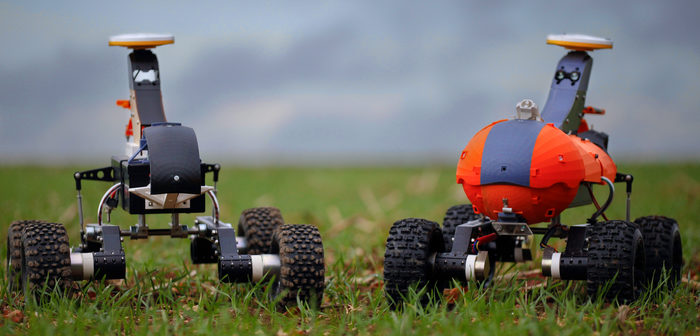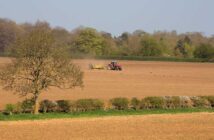Small Robot Company, a British agritech start-up for sustainable farming, has announced its first commercial service for weed mapping. This is the world’s first service for individual plant mapping at broadacre scale.
This is a major technological milestone, for the first time providing farmers with a per-plant view of their fields.
SRC also previewed the next generation of its Tom monitoring robots at the Expo. Its first robust commercial robot, this is designed to deliver the new commercial service, and is planned to enter service this growing season. Tom will cover 20 hectares per day autonomously. He can distinguish plant details at submillimetre resolution, with less than one millimetre per pixel resolution on the ground.
This is a significant milestone for the company’s delivery following its £1.2 million Crowdcube equity crowdfunding raise ten months ago. The next development milestone will then be non-chemical weeding, with an initial prototype anticipated at the end of this year. Early field trials are due to commence in 2020.
Andrew Hoad, partner & head of Waitrose’s Leckford Estate, which will be taking up the new service, comments: “This technology could be truly groundbreaking and has the potential to shape how we farm in the future. By helping us be more precise and targeted in controlling weeds and managing pests, this next generation of farming robots could in turn help us protect biodiversity on our land and preserve the natural environment for future generations.”
Groundbreaking service
Initially focused on broad leaved weeds (BLW), grass-type weeds such as blackgrass will follow later this growing season. Priced at £15 per hectare, the service will also map emergent wheat.
SRC will also be releasing an early version of its Wilma artificial intelligence interface for farmers to view and interpret the data for decision support. It is anticipated that integration with existing Farm Management Information Systems (FMIS) will help make current machinery more efficient, for instance for variable rate spraying.
“This is truly a world-first. It’s a very significant milestone both for our own technological progression, and in agriculture’s move to digital,” says Sam Watson Jones, co-founder, Small Robot Company. “For the first time, we now have a per plant view of the field at broadacre scale. This is a data set that has never previously exited in farming. This opens the gateway to an entirely new way of farming, and to systemic change.”
“This is the major delivery milestone we set out to achieve with our Crowdcube fundraiser last year. The huge stride is that we will offer a commercial service,” comments Ben Scott-Robinson, co-founder, Small Robot Company. “Tom will gather data at two hundred times the pace that the first generation Tom could do. Robust, weather-proof and farm-scale. It’s been amazing to go from the drawing board to a situation where we’ll have robots in the field collecting information that customers will be paying for in the space of a few months.”
First commercial service: the benefits
To begin with, the service will be delivered on four of SRC’s existing trial farms, including the Waitrose Leckford Estate and the National Trust Wimpole Estate.
Identification of weeds in the field is possible thanks to the Wilma artificial intelligence neural network the team has been developing over the last eighteen months.
Wilma can now detect both BLW and emerging wheat, following extensive training using tens of thousands of images from the last year’s data collection. Work is now underway for identification of grass type weeds such as blackgrass, brome and ryegrass, the mapping of which is scheduled to follow next autumn.
Working in conjunction with Wilma, the Tom robots will be identifying BLW to:
- Measure the efficacy of BLW herbicide applications by doing a post-spray weed count
- Map weed populations to allow for focussed remedial treatments the following year
- Inform decisions as to whether farmers spray or don’t spray for BLW, particularly in the
The data on emerging wheat provides a highly accurate tiller count which:
- Influences crop management decisions throughout the season, in particular by the ability to apply variable-rate nitrogen on the areas where plant density is low
- Can be overlaid with an existing yield map to determine optimum plant population in future years
- Influences future planting decisions for plant density. This data could additionally produce a yield map to help farmers assess the ideal size of plant population for their field as well as opening the way for variable rate drilling
- Can give an indication as to vulnerable areas for slugs
This technology may in the future be able to deliver accurate yield predictions far earlier by providing highly accurate tiller counts at an early stage and then providing an ear count at a later stage.
Next generation Tom design
The next generation Tom design incorporates factors such as weather-proofing, speed, camera capacity and extended battery life. Designed from the ground up, it is carrying double cameras, exponentially increasing monitoring capacity to four metres squared and enabling it to cover 20 hectares per day.
The new Tom weighs only a few hundred kilograms, and will be truly autonomous. For the initial service, it will be handled by a single robot operator. It will fit in a small van and can be easily taken from one farm to another, an important capability for Small Robot Company’s Farming as a Service (FAAS) model.
“It’s a crucial part of our strategy that we are developing on farm, with farmers, so that what our engineering team design in the lab then delivers in field. So what we’re going to see over the next year is potentially that we’re going to go through three or four iterations of this prototype Tom robot. This will get us to the point where we can go through an industrial design process to have a robust commercial design for these robots, at which point we enter manufacturing and can scale up,” concludes Sam.
Crowdcube delivery
The new service also means Small Robot Company has successfully fulfilled a key delivery milestone it set out to investors during a Crowdcube equity crowdfunding campaign that raised £1.2million just ten months ago. The campaign’s huge success was overwhelmingly due to backing from the farming community.
Over the last year, the funding achieved through the Crowdcube campaign has allowed the Small Robot Company to move to a purpose-fitted new workshop as well as growing the team together with its expertise in robotics, mechanical engineering and electrical engineering.




